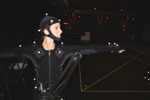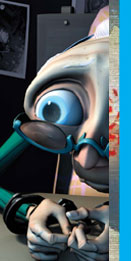教育論文
 フルカンファレンス
フルカンファレンス
 1日券
1日券
世界9カ国の教育者によって17件の発表があります。これらの教育論文は、応募総数43件からピアレビューワーと審査委員会によって厳選されました。 5つの英語のセッションと2つの日本語のセッションがあります。
SIGGRAPH Asia 2009 Education Papers:
Animation
Thursday, 17 December | 10:45 AM - 12:30 PM | Room 414/415
Session Chair
Steve Cunningham
Educating Technophile Artists: Experiences From a Highly Successful Computer Animation Undergraduate Program

In the past few decades, the arts have become increasingly dependent on and influenced by the development of computer technology. In the 1960s, pioneering artists experimented with the emergent computer technology, and more recently the majority of artists have come to use this technology to develop and even to implement their artifacts. The traditional divide between art and technology has been breaking down to the extent that many artists consider themselves technophiles. In truth, this divide has never existed. Throughout history, artists have always used and exploited available technology and frequently led the development of new technology that would allow them to express their creativity. For instance the ancient Greek word for art was "techni", the root for the word "technology". The artificial and harmful divide between the arts and sciences was introduced in the western educational system in the 19th century, and it is high time that it was bridged or removed altogether. To this end, the National Centre for Computer Animation at Bournemouth University has pioneered a number of university degrees that aim to blur the difference between artists and scientists and technologists. This paper explores the design of such courses and shares experiences, successes, and trials and tribulations in implementing degrees in computer animation, games, and digital effects.
Peter Comninos Leigh McLoughlin Bournemouth University Eike Anderson Coventry University
Teaching Animation in Computer Science

The main functionalities of open-source software are now similar to the functionalities of commercial software, but the open-source community provides very valuable documentation, examples, and tutorials, at little or no cost. For these reasons, Blender software was selected to support an animation course for computer-science students. As undergraduates, students began by using OpenGL in a computer-graphics course. Later, during their masters studies, the students took the animation course, where they learned the main modeling and animation techniques. Production of an animated film involves several steps, but some of them are not taught in this animation course. Its focus is more technical than artistic, in particular modeling and animation techniques. Nevertheless, the films revealed each student's skill as a director, a producer, an editor, and animator, etc. Blender is an excellent choice for 3D creation. It is a good tool for learning, especially for topics such as modeling and animation techniques, and it is the only software that supports all the technical steps of film production.
Frutuoso Silva Universidade da Beira Interior
Developing Practical Models for Teaching Motion Capture

Motion-capture technology is increasingly used across a range of digital moving image practice, from 3D animation, digital visual effects and gaming to digitally augmented live performance and dance. This paper presents a range of preliminary pedagogical and research issues that have arisen at the early stages of developing teaching modules around the use of low-cost, entry-level motion-capture technology at the School of Art and Design, Auckland University of Technology. The motion-capture system is Optitrack’s economical eight-camera optical motion-capture package. This initiative represents a first step in integration of motion capture within an existing digital-moving-image program and was conceived to address of a number of core pedagogical and research aims in 3D animation, performance, and motion capture. At this stage, the pedagogical aims are focused on two areas: 1. Character animation: the use of motion capture as an aid for teaching animated performance and exploring the relationship between classical animation principles and motion-captured movement. 2. Developing director and performer skill sets. How to direct and perform effectively with motion capture for shifting project and performance mode requirements. Within these particular fields, a number of issues arise: questions of motion capture versus classical animation technique, stylised or exaggerated versus naturalistic performance modes, motion-captured movement applied to stylized character models and/or photo-realistic models, the translation from "live" to digital movement, and the digital processing of performance.
Gregory Bennett Andrew Denton Auckland University of Technology
The Seduction of Realism

A prime goal of animation is the “illusion of life”, which requires an illusion of reality. Though realism can be described in many ways, the overall aim is to give the animation some real-world authority that fulfills the illusion and increases immersion for the viewer. Traditionally, animation has often been represented through real-world informed movement, which is often stylistically exaggerated. Exaggerated character movement is drawn from real life, creating a poetic explicitness that increases the perception of movement and the life of the character. This exaggeration of motion compensates in some ways for the otherwise unreal nature of the animation medium. In recent years, with the advent of computer-generated 3D animation, more convincing visual realism has become achievable. Though the exaggerated styles of traditional animation are often maintained, the unique qualities of the digital 3D medium provide an extra layer of visually convincing realism. One interesting consequence is that as realism increases, exaggerated movement and artistic interpretation decreases. The ultimate solution suggests absolutely realistic rendering, with absolutely realistic movement. Is this still animation, or is it something else? Is it still an expressive and creative medium? The realism that technology provides for animators also creates new demands for educators. Should educators stay with the founding principles? How do educators embrace technology while retaining the expressive individuality that animation can provide. Should they adopt the new media, such as digital sculpting and hyper-realism? And when does new technology create new areas that have little to do with the definition of animation? This paper discusses new expectations of realism in animation education, and via a journey down the Uncanny Valley, suggests some approaches and philosophies that can move with technology while retaining artistic independence and actively managing the seduction of realism.
Gray Hodgkinson Massey University

